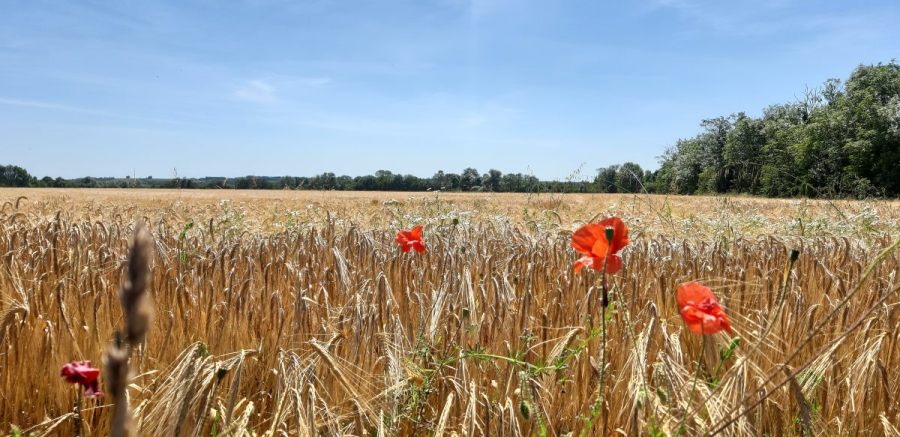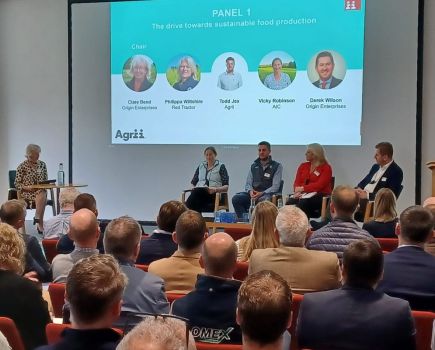More and more farmers are making room for nature on their farms, reversing the trend in the biodiversity loss that’s become associated with modern farming practices. CPM visits a farm putting this into practice while trying to reconnecting with consumers with their food.
If you make space for animals and birds across your farm, they’ll bring a lot of benefit to you in other ways.
By Lucy de la Pasture
“Wildlife doesn’t fit into a box. It’s not possible to relegate it to one corner of a farm, a grass margin or a hedgerow. We want to farm in such a way that biodiversity is supported across all parts of the farm.”
That’s how Tim Scott, tenant farmer at Lark Rise Farm in Cambridgeshire and trustee of the charity, Countryside Restoration Trust (CRT) views the way his business integrates with the countryside, of which it’s very much a part.
His farm was the first property the CRT purchased in 1993, the same year the charity was established. It’s also the CRT’s only arable farm amongst its portfolio of 19 farms, woodlands, and small holdings, with most of its properties being used for the rearing of livestock.
Now spanning 162ha, the original Lark Rise was comprised of just one field that was purchased following the publication of an article in The Telegraph by the CRT’s founders. Their vision was to support a living, working countryside but, at the same time, reverse the impact of intensive farming practices and restore biodiversity to the British countryside, once teeming with birds, mammals and insects.
The article stirred hearts and minds, and generous donations quickly poured in to support the charity’s cause of making space for wildlife across fields, woodlands and wetlands.
Tim was the first tenant on ‘Telegraph field’ and has remained at Lark Rise ever since. He comes from a Cambridgeshire farming family and is a conservationist and advocate for the rural economy and local community.
It was Tim’s sensitive but productive approach to land management that secured him the tenancy, but it was also important to the charity to be a ‘broad church’ that brought together the breadth of the farming community to promote wildlife-friendly farming. Tim’s background of working in the agrichemical industry therefore positioned him as the ideal advocate for achieving record numbers of Biodiversity Action Plan (BAP) species while using conventional farming practices.
“In the farming community we experience a lot of peer pressure. It’s difficult to change, especially when farmers will have a long-term plan. But while insects and birds can’t pay you rent, if you make space for them across your farm, they will bring a lot of benefit to you in other ways,” he says.
Tim’s approach to wildlife-friendly farming is to focus on the details and achieve a balance for nature. That means creating habitats across the farm that benefit wildlife, providing them with the four essentials – food, water, habitat, and space to roam. At Lark Rise, wildlife is integrated throughout the farm because making space for invertebrates, beetles and bees can help boost output, explains Tim.
“Leaving tall, wild grass margins around the edges of fields, or planting beetle banks that run through the centre of a field, can provide essential corridors for wildlife, while helping them to do important work on the farm, such as natural pest control or pollination. Encouraging aphid predators to set up residence in beetle banks reduces the need for artificial inputs to control them. This saves money in the longer term,” he says.
His fields are easy to spot around the villages of Comberton and Barton because they probably appear a little untidier than his peers’ fields, he says. “You might see broad, uncut hedgerows and clumps of weeds amongst the crops, but these provide much-needed food and habitats for wildlife. Rare arable weeds, such as the shepherd’s needle, are also left to grow, as a BAP priority species.
“Weeds support insects, which in turn support birds. Field mice will eat their seeds, providing prey for barn owls. Weedy over-wintered stubble is an important food source for birds, while also providing green cover and protecting the quality of the soil,” he explains.
Direct drilling is another technique that’s markedly improved the abundance of soil invertebrates. Walking across Lark Rise in the winter months, it’s striking to see the difference in birdlife populations flying around drilled fields compared with neighbouring fields, also farmed conventionally. While Tim’s fields may be untidier, they’re teeming with skylarks, starlings and hares.
“If you look across a field, and you can’t really see anything, the chances are that there’s nothing there,” he says.
A key mission of the CRT is to engage local communities in food, farming and wildlife, with the aim of re-establishing the connection between fork and field which has now been largely lost. That includes public walks and talks at Lark Rise Farm and social media activity, such a livestreamed tour of the farm on Facebook. The Barton Community Orchard at Lark Rise was planted by local conservation volunteers and is open to the public all year round so that they can enjoy the trees and gather its fruits.
“An important aspect of this is inviting the local community onto the farms and involving them in our conservation practices so that we can build stronger links between people and nature.
“We’re lucky to have a large group of supporters in Cambridgeshire who are all united by their passion for regenerating the British countryside and are very generous with their time and contributions to the farm.”
That’s evidenced by the fact the CRT and its volunteers have planted almost five miles of hedgerows at Lark Rise since it was first purchased. In so doing, its largest field was immediately broken up into four smaller parcels of land by a network of hedges.
In 2018, Lark Rise hosted the National Hedge Laying Championships and in late 2021, ITV Anglia producers visited the farm to showcase hedgerow management best practice.
“Our hedges typically comprise 14 different native species of bush, shrub and tree – including blackthorn and hawthorn. Care is also taken to plant the hedges in different styles around the farm, as some animals prefer a regimented hedge, others look for hedges that have been traditionally laid and stand quite dense, and others seek out self-seeded patches.”
Working with Tim is CRT’s head of wildlife monitoring, Dr Vince Lea. The conservation volunteers have adopted various approaches to hedgerow management, including some regular cutting, some are cut on one side every two years, and some hedges are left to grow tall, broad and bushy.
“This provides a diversity of habitats and sustenance for birds in the form of berries and buds. The hedges’ capacity for sequestering carbon is also maximised,” he says.
Sensitive farming practices combined with conservation activities, and some supplementary feeding from grey partridge-enthusiast Tim, have generated fantastic results for Cambridgeshire biodiversity. The wildlife monitoring data speaks for itself.
“A starting point of just one bat per six hours was recorded at Lark Rise in 1999 whereas in 2019, 11 bats per hour were recorded, representing a 70-fold increase.”
Lark Rise’s Farmland Bird Index has also risen over the past 20 years, while nationally it has continued to decline, says Tim. “The fields here have seen a four-fold increase in grey partridge populations and we recently received a Redlist Revival Life on Land Award for the ‘Highest Density of Grey Partridge’.
“Lapwings have also returned as a breeding species, drawn in by the weedy, over-wintered stubble. Skylarks, yellow hammers and song thrushes are all a common sight, and a great grey shrike was also spotted late last year hunting around the fields.
“Grey partridges, for me, represent a connection to my late father’s childhood. This fascinating little bird was commonplace on all farms and is now largely missing from most arable farms. He would always speak very fondly of them,” says Tim.
There’s a tendency to view nature-friendly farmers as the hippies of the farming world, though this stereotype is gradually being thrown off as more and more arable farmers become rooted in agroecological principles. But Tim has a close working relationship with Syngenta, initially as an employee and latterly on a contractual basis.
In fact, that was one of CRT’s motivations for bringing him in as its original tenant, says Tim, in the hope he would leverage his links with the crop protection industry. “It’s possible to farm sympathetically and support an abundance of wildlife on a conventional arable farm and still achieve good yields.”
A brilliant illustration of this was when he hosted a visit from the Crop Protection Association, and the visitors were drowned out by skylark song overhead, he smiles.
Starting in pure research and development, Tim then moved into spray application and still assists the Syngenta team to this day. “The most recent nozzles to be developed are those with 90% drift reduction. These carry a massive environmental benefit as they virtually eliminate spray drift while maintaining high level of efficacy. Their impact is most apparent in the control of blackgrass,” explains Tim.
Lark Rise Farm has played host to a long-term blackgrass cultivation trial where ploughing, min-till and direct drilling techniques have been compared over the past six years. The results were so impressive for both the yields and environmental benefits of direct drilling that Tim has direct drilled 25% of his acreage for the past three years.
The CRT is welcoming the winds of change, brought on by the UK Government’s Agricultural Transition plan, and the three ELM schemes that have been announced post-Brexit. In particular, the Local Nature Recovery Scheme is a win for charities like the CRT, which has been campaigning for wildlife-friendly farming for almost 30 years, adds Tim
“With the Basic Payment Scheme being phased out completely by 2027, it’s essential the Government moves quickly in providing additional detail so that farmers and landowners can prepare for these important changes.
“With the majority of the CRT’s farms being small-scale and family-run, we’re calling for the Government to ensure that they don’t leave small farms and tenants behind in this agricultural transition,” says Tim.
“We’re also clear that the details of the Local Nature Recovery Scheme, when announced, must be bold and ambitious in its objectives and scope. As was highlighted in the ‘Nature Positive by 2030’ report by the JNCC, the public body which advises the Government on nature conservation, it’s essential that we tackle the crisis of biodiversity loss by restoring and creating habitats in the short term.”
This transition is taking place against the backdrop of a changing climate and the target to reach net zero carbon emissions by 2050. Farmers are already adapting to more unpredictable weather patterns, and if left unchecked, these will continue to have an impact on food, farming and wildlife, he believes.
“I’ve witnessed significant changes in Cambridgeshire weather over the past few years. Winter is stretching longer into spring, and we’re experiencing heavier rain in autumn.
“As farmers, we’re always thinking on our feet, but the weather is becoming increasingly unpredictable and harder to plan for in the longer-term. But we need to think longer-term about what steps we can take to adapt to a changing climate and share knowledge and best practice with each other,” concludes Tim.




